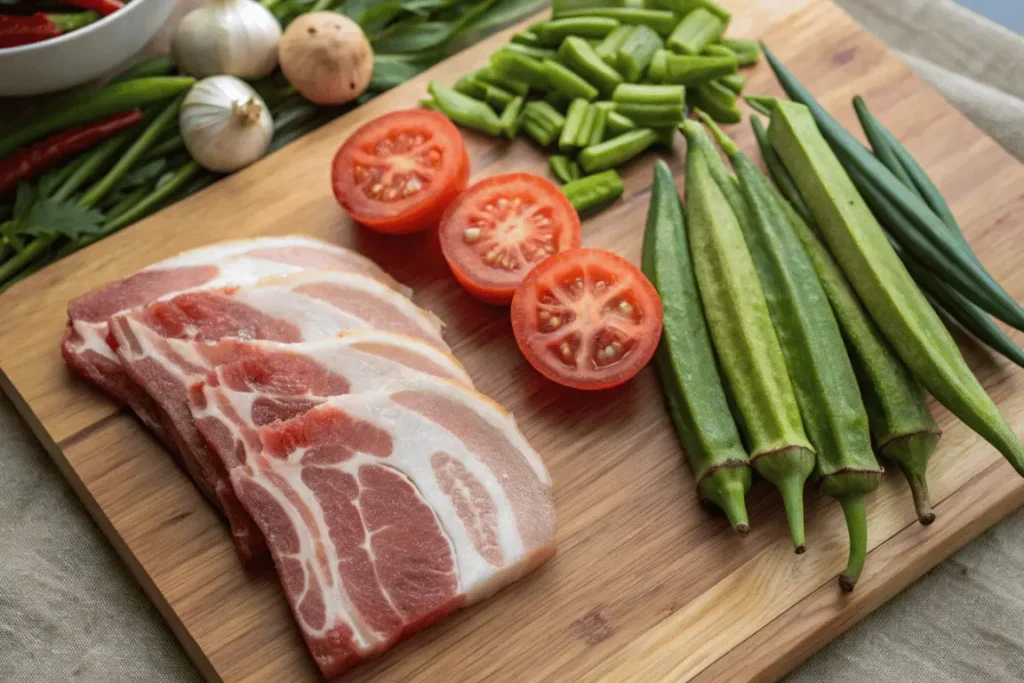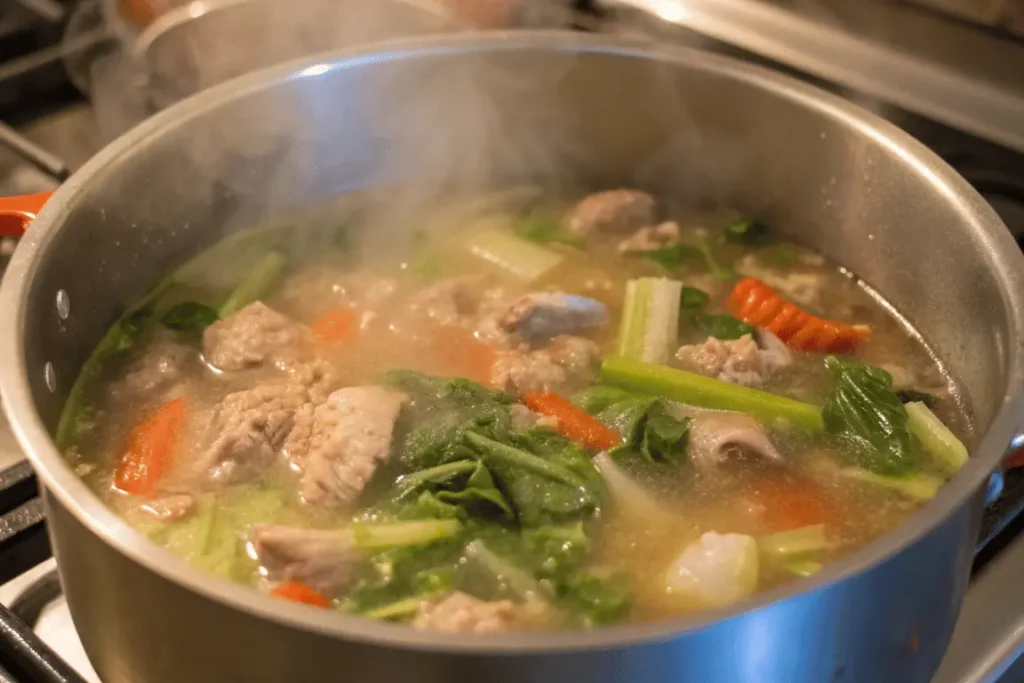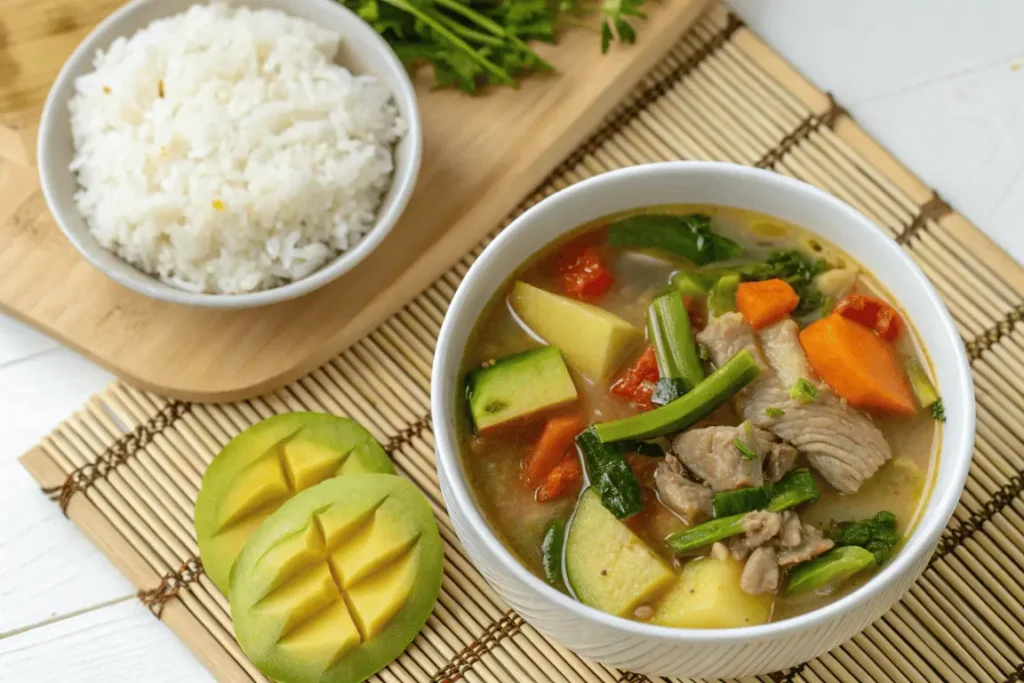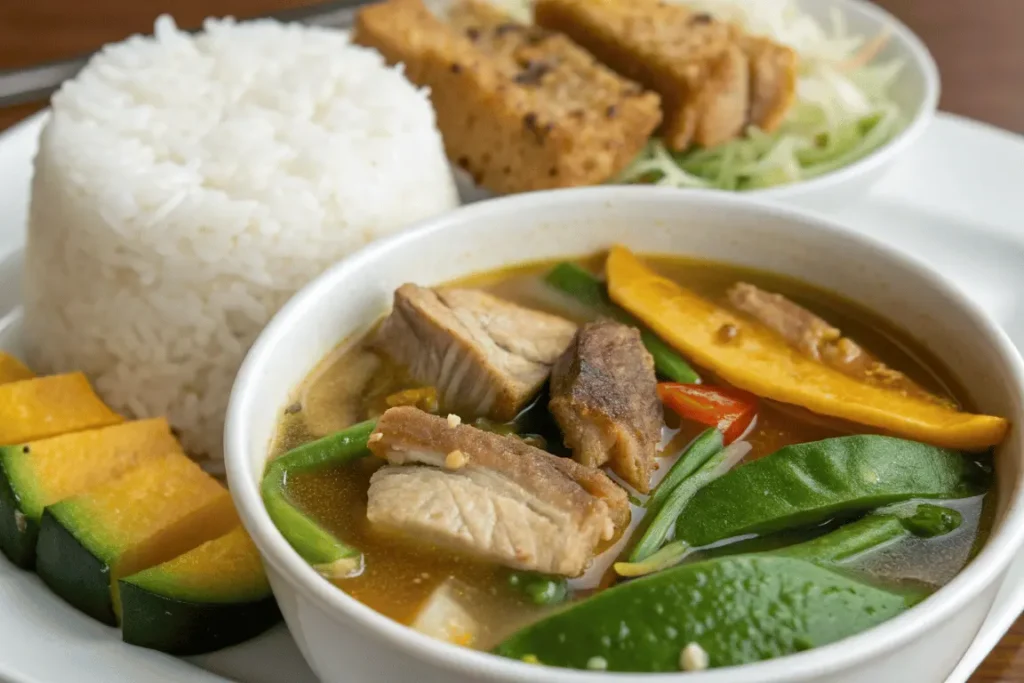This isn’t one of those flashy dishes. It’s not trying to be. Pork Sinigang Recipe just good food. Sour, warm, soft meat, lots of veggies. You’ve had it if you grew up around a Filipino household, and if you haven’t, you’re in for something comforting.
You make it when it rains. When someone’s feeling off. Or when there’s not much in the fridge but enough to throw in a pot. That’s the kind of dish sinigang is. No exact rules, just flavor.
Everyone’s got a version. Some go heavy on the tamarind. Others mellow it out. Some skip tomatoes. Some load it with every green in the market. And that’s fine. The broth does the work, and everything else just fits in.
You don’t need to know how to cook to make sinigang. You just need to want something real.
Jump to

Sinigang Recipe
- Total Time: PT1H40M
- Yield: 6 servings 1x
Description
Best Pork Sinigang Recipe with tender meat, bold flavor & homemade broth. Learn how to cook it right.
Ingredients
2 lbs pork belly or ribs (bone-in preferred)
1 medium onion, sliced
2 large tomatoes, quartered
1 cup fresh tamarind pulp or 1 pack sinigang mix
2 gabi (taro roots), peeled and cubed
1 cup sitaw (long beans), cut into 2-inch pieces
1 daikon radish (labanos), peeled and sliced
1 medium eggplant, sliced
2 cups kangkong (water spinach) or bok choy
1 tbsp fish sauce (or to taste)
1 tbsp oil for sautéing
6 cups water
Optional: 1 long green chili (siling haba)
Instructions
Heat oil in a large pot. Add onion and sauté until translucent.
Add tomatoes. Cook until soft and starting to break down.
Add pork pieces and brown slightly on all sides.
Pour in water. Bring to a boil, then lower heat. Simmer for 45–60 minutes, skimming fat.
If using fresh tamarind, boil and mash separately, strain and add tamarind juice to the pot. For sinigang mix, dissolve and stir directly into broth.
Add gabi and daikon radish. Simmer for 10–15 minutes.
Add eggplant and sitaw. Cook another 5–7 minutes.
Taste and season with fish sauce as needed.
Add kangkong and green chili last. Cook 2–3 minutes, then turn off heat.
Serve hot with steamed rice and sides.
Notes
Use pork neck bones or shoulder for more flavor.
Tamarind paste or frozen tamarind blocks also work if fresh tamarind isn’t available.
Add a splash of calamansi juice or green mango for extra tang.
Adjust sourness gradually—start small and build flavor.
This recipe can be made in an Instant Pot or slow cooker too.
- Prep Time: PT20M
- Cook Time: PT1H20M
- Category: Main course
- Method: Simmering / Boiling
- Cuisine: Filipino
Nutrition
- Serving Size: 1 bowl
- Calories: 395
- Sugar: 5g
- Sodium: 780mg
- Fat: 25g
- Saturated Fat: 8g
- Unsaturated Fat: 13g
- Trans Fat: 0g
- Carbohydrates: 16g
- Fiber: 3g
- Protein: 23g
- Cholesterol: 65mg
What Is Sinigang?
Where It Comes From
It’s old. Way before we started writing down recipes, families were boiling meat in sour fruit and calling it dinner. Sinigang isn’t fancy, never was. Just stew with a twist. Tamarind’s the go-to, but folks use whatever grows near them. Kamias, guava, green mango, all of it works.
It’s Filipino, no doubt. You won’t find sinigang done like this anywhere else. The sourness isn’t just a note — it’s the main thing. Not lemony, not vinegar-sour. It’s round, earthy. You taste it, and it wakes you up.
Why It’s That Soup Everyone Talks About
In 2021, someone online said it’s the best vegetable soup in the world. We already knew that. The broth’s bright, not boring. Pork’s tender. Veggies hold up in the heat. Everything tastes like it belongs.
And more than that, it’s familiar. Even when you’re not at home, it brings you back. Maybe that’s what made it stand out. Not just the flavor—but the feeling.
Sinigang Ingredients: Proteins, Vegetables & Souring Agents

Pork and Other Proteins That Work
Most people go for pork. It’s rich, fatty enough to hold flavor, and stays tender when stewed for a while. Pork belly? Sure. But ribs, shoulder, neck bones—those give the broth depth. The bones matter. Without them, you miss that background savoriness.
Not into pork? Shrimp’s great. Bangus (milkfish) too. Some throw in beef short ribs, though that’s heavier. Chicken? It’s doable, but you lose that richness sinigang usually has.
Whatever meat you use, give it time. Rushing it makes the broth flat. Let it go low and slow.
The Vegetables and Why They Matter
You could make this dish with just pork and tamarind, but it wouldn’t feel complete. The vegetables balance the soup.
- Kangkong (water spinach): quick to cook, gives a fresh, leafy contrast.
- Sitaw (long beans): adds crunch and texture.
- Labanos (daikon radish): soaks in the flavor, adds a gentle bite.
- Gabi (taro): creamy, thickens the broth naturally.
- Eggplant: soft and smoky if cooked well.
- Tomatoes: they’re not optional—they start the broth off right.
It’s not about piling in as many veggies as possible. It’s about picking the ones that hold their own in a sour broth. And always layer them. Don’t dump them all in at once.
The Sour Stuff: Fresh, Powdered, or Bottled?
Fresh tamarind is the gold standard. You boil it, mash it, strain it into the pot. Takes time, but nothing beats the taste.
Tamarind paste works if you can’t find fresh. Easier, still close to the real deal. Just go easy—it’s concentrated.
Powdered sinigang mix? Yeah, a lot of people use it. It’s fast. Tastes decent. A bit salty. The flavor’s sharper, less natural, but it’ll do in a pinch.
Some swear by kamias (a sour fruit from backyard trees), or guava, or even green mango. All of those give the broth different personalities. Guava adds thickness and a subtle fruitiness. Mango’s cleaner, sharper.
Point is—there’s no rule. Use what you’ve got. Just don’t skip it. Without that sour base, it’s not sinigang.
Regional & Creative Sinigang Variations
You’d think sinigang’s the same everywhere. It’s not. Depends where you are. Depends who’s cooking.
The Pork One Everyone Knows
It’s the one most people grew up eating. Pork belly, pork ribs. Sometimes shoulder. Always bone-in—has to be. That’s where the broth comes from.
You start with tomatoes and onions. Garlic if you want. Then the meat. Tamarind, water. Let it go. Add veggies near the end. Sitaw. Labanos. Kangkong if you’ve got it. Maybe eggplant.
There’s no secret to it. It just works.
The One With Miso and Fish
This one’s different. Has miso. Yellow kind. Adds saltiness, thickness.
Usually you use milkfish—bangus. Some use other white fish. You cook the miso first. Garlic. Onion. Then water, souring agent. Still has tamarind. But the miso changes everything. Softer taste. Rounder.
Chili sometimes. Mustard leaves too.
Don’t miss our rich ditalini pasta recipe soup for comfort food fans.
When You Use Fruit Instead
People get creative. Not because they want to. Sometimes it’s what they have.
- Bayabas – That’s guava. Sweet-sour. Makes the soup thicker.
- Kamias – Super sour. Sharp. Not for everyone.
- Green mango – Young ones. Not sweet. Gives a clean kind of sour.
- Pineapple – Not common. But some do it. Especially with shrimp.
It still tastes like sinigang. Just dressed up different.
No Meat, No Problem
You can skip meat. Not the flavor though.
Use mushrooms. Tofu. Maybe miso again. Gabi’s good too. Thickens the soup.
You still need tamarind. That sour hit. Then throw in whatever veg you like. Labanos. Eggplant. Okra. Whatever’s fresh.
It’s not less. It’s just different.
How to Cook Sinigang Step-by-Step
This isn’t hard. Just needs time. No rushing. You don’t cook sinigang fast. You build it.

Step 1 – Start with the Base: Garlic, Onion, Tomato
Heat oil. Not too much.
Toss in garlic. Let it brown, not burn. Then onions. Let them go soft. Tomatoes after that. Break them down. You want that sour-sweet tomato base to melt into the oil.
Some people skip garlic. Some don’t sauté at all. That’s fine. But doing it this way adds something deeper.
Step 2 – Tamarind Goes In (or Whatever You’re Using)
If it’s fresh tamarind, boil it in water first. Smash it. Strain it. That water? That’s your sour.
If it’s a packet? Stir it straight into the broth later. Powder, paste, mix—up to you. Start with a little. Taste later.
This is where the soup starts to change.
Step 3 – Add the Pork, Simmer Low
Now you add the meat. Pork belly. Neck bones. Whatever cut you’re using. Add enough water to cover. Bring it to a boil. Then drop the heat. Let it simmer.
Leave it alone. 45 minutes. Maybe more. Skim the fat off if you want. If bones are showing, you’re doing it right.
Learn more about Filipino-inspired Garlic Noodles Recipe Online.
Step 4 – Veggies Go In, One by One
Don’t dump everything in at once. That’s how you end up with soggy kangkong and hard radish.
Start with gabi or labanos—they take longer. Then eggplant, sitaw. Last: leafy greens like kangkong or mustard leaves.
Cook until just tender. Don’t overdo it.
Step 5 – Taste It, Fix It
Now you taste.
Too bland? Add fish sauce. Not sour enough? More tamarind. Too salty? Bit of water, or throw in a tomato.
This part’s personal. Everyone’s idea of perfect sinigang is different.
Don’t forget: turn off the heat before your greens go too soft. Let it sit. Flavor deepens after a few minutes.
Cooking Methods Compared: Stovetop • Instant Pot • Slow Cooker
There’s more than one way to cook sinigang. Doesn’t mean they’re all equal. Depends what you’re after—flavor, time, texture.
Stovetop (The Old-School Way)
Still the best way if you’ve got the time.
You see everything. Smell it change. Adjust as you go. Watch the broth turn from clear to cloudy. Add veggies by feel. Taste it every so often.
Meat comes out soft, not falling apart. Just enough chew. Fat renders slow. Veg stays alive if you time it right.
Downside? Takes a while. Needs checking. Can’t just walk away.
But if you’re learning, start here. This is where you figure out the dish.
Instant Pot (Fast, But Watch It)
Cuts the time. Like, a lot.
You brown the meat in the pot if you want. Then broth, aromatics, pressure cook. About 30 minutes total. Maybe less. Veggies go in after—you still want control there.
The pork turns out soft. Sometimes too soft. Gabi gets mushy fast in pressure cookers. Greens? Never pressure them. Add at the end, use the sauté mode.
Flavor’s decent. Not as layered. But for a weekday? It works.
Good if you’re in a rush and still want something that tastes like home.
Slow Cooker (Set It, Forget It… Kind Of)
This one’s a lazy-day choice.
You put the meat and sour stuff in early. Onions, tomatoes. Let it go. Low and slow. Hours. The broth gets deep. Real deep. Bones melt down. Pork? Fork-tender.
Only thing—you’ve got to add veggies near the end. Or they’ll be mush. Like baby food mush.
Also: sauté your aromatics first. Don’t just dump everything raw. That step changes the whole game.
It’s great if you’re not home but still want sinigang ready by dinner. Flavor? Rich. Clean. But you lose some control.
Sinigang Mix vs. Homemade Tamarind Broth: Flavor & Health Face-Off
Some people say if you don’t use fresh tamarind, it’s not sinigang. Others? They’ve been using the powdered stuff for years. Truth is, both work. Just depends on what you want out of it.
Flavor – What You Taste in the Bowl
Homemade broth from real tamarind has a rounder flavor. Sour, yeah—but not sharp. There’s a fruitiness to it. It builds as it simmers. Feels more alive. Has depth.
You get that kind of tang you can’t fake. It doesn’t punch you. It lingers. You sip the broth and want more. No weird aftertaste. Just clean, fresh sourness.
Now sinigang mix? It hits harder. Almost too direct. Sour right away. Some brands are saltier. You get that MSG hit, and for a lot of folks, that’s what they like. It’s fast. It tastes good. But it’s not subtle.
Side by side, the fresh broth wins on flavor—but the mix wins on convenience.
Health – What’s Actually Inside
Fresh tamarind is just fruit. That’s it. You boil, mash, strain. No chemicals, no additives. If you’re watching sodium or preservatives, this is the way to go.
Sinigang mixes? Check the label. Most have salt, flavor enhancers, citric acid, maybe even food color. Some brands load them up. It’s fine once in a while. But if you’re eating it often or feeding kids, might be worth making it fresh now and then.
That said, not everyone has access to fresh tamarind. And if the choice is between sinigang mix or no sinigang at all? Go with the mix. It still warms the soul.
Is Sinigang Healthy? Nutrition Facts & Wellness Benefits
Short answer? Yeah, it can be. But like most dishes—it depends how you make it.
Calories, Macros, All That Stuff
A bowl of sinigang, just broth, pork, and veggies? You’re looking at around 250–400 calories. Give or take. Mostly depends on the cut of pork. If it’s belly? That number climbs. Ribs? A little less. Leaner cuts? Even better.
It’s got protein, especially from the meat. Veggies add fiber, vitamins. Broth hydrates. If you’re using gabi, you’ll get carbs. It’s balanced, if you build it right.
But throw in too much rice or fatty pork every night? Yeah—it adds up. Like any comfort food.
The Sodium Problem
This is where the sinigang mix hits hard. It’s salty. One packet? Sometimes over half your daily sodium.
Now, if you make it fresh—real tamarind, fish sauce only as needed—you control it. You decide how much goes in. That’s the difference.
Cutting back? Use more tomatoes. Add lemongrass. Or throw in a little chili. You don’t need to drown it in salt to bring out flavor.
How to Make It Even Better for You
Want it cleaner?
- Use lean pork. Shoulder over belly.
- Go big on the greens. Kangkong, mustard leaves, bok choy.
- Skip frying anything beforehand.
- Drop in mushrooms for bulk instead of extra meat.
- Use brown rice if you’re watching carbs.
It’s not diet food, but it doesn’t need to be junk either. It’s homemade. You’ve got control.
Explore creative sweet sides with this plantain recipe.
Pro-Level Tips & Common Mistakes to Avoid
Been cooking sinigang a while? These are the things that make the difference between good enough and that’s the one we remember.

Don’t Over-Salt to Fix the Sour
Big one. People taste their broth, feel like the sour’s missing, and start dumping in more fish sauce. Doesn’t work.
If it’s not sour enough, fix the sour. Add more tamarind or mix. Don’t fix one flavor by ruining another. Salt and sour aren’t the same thing.
You want balance. Not a salty punch to the throat.
Cook Veggies in Layers. Always.
This isn’t adobo. You can’t just throw everything in and walk away. Gabi goes in early. Sitaw somewhere in the middle. Kangkong last minute.
That’s how you get veggies that hold their shape. Still have texture. Not a green mush floating on top.
People mess this up all the time. The soup’s perfect, but the veg is gone. Lifeless. Don’t do that.
Skim the Broth, or Don’t — But Know Why
Some folks like a clear broth. Others don’t care. That foam on top? Comes from fat, scum off the meat, boiled proteins. Skim it if you want it clean. Don’t if you want it richer.
Just don’t stir it back in. That makes it cloudy and greasy.
If you’re going for clean, take your time. Don’t boil hard. Simmer slow, skim as you go.
Taste Before You Finish
Seems obvious. But a lot of people forget.
You’ve got pork. Tamarind. Fish sauce. Vegetables. All throwing flavor into the pot. Every time you make sinigang, it’s going to be a little different. So taste it. At least twice before you serve.
Too flat? More sour. Too salty? Drop in a few tomatoes or a splash of water. You adjust based on what you feel. Not what the recipe says.
That’s cooking.
What to Serve with Sinigang: Best Rice, Sides & Drinks
You can eat sinigang by itself, sure. But it always hits harder with the right extras. The broth’s the star—but everything else? That’s what makes it a full meal.

Rice. Always.
You already knew this. No one eats sinigang without rice.
Plain white is classic. Jasmine or long grain. Something soft to soak up the broth.
But don’t stop there.
- Garlic rice? Yep. Adds punch. Soaks up sour and gives a little crunch if you fry it right.
- Brown rice? Works too. Earthier, chewier. Makes the dish feel a bit heartier.
No need to overthink it. Just make enough. Because you’re gonna want seconds.
Fried Stuff on the Side
Sinigang’s soft and soupy. So a crisp side? Perfect contrast.
- Fried bangus (milkfish): Classic combo. Sour soup + crispy skin.
- Tofu, deep-fried: Crunch outside, soft middle. Dips right into the broth.
- Crispy pork belly: Decadent, yeah—but balances out the sour.
You want texture. Something to bite.
Check out this cozy turkey lasagna soup variation.
Fresh Stuff Too
Balance it out.
- Green mango salad: Sour on sour, but it works. Add bagoong if you like salt.
- Ensaladang talong (eggplant salad): Grilled, peeled, with tomatoes, vinegar. Cleans the palate.
- Cucumber salad: Cold and sharp. Keeps the meal light.
Some people like having chili vinegar or calamansi on the side too. For when the broth isn’t quite sharp enough.
What to Drink?
Nothing fancy.
- Iced calamansi juice: Refreshing. Matches the vibe.
- Pineapple juice: Sweet to cut through the sour.
- Cold beer: If it’s dinner and you’ve earned it.
You don’t need soda. You don’t need wine. You need cold, clean, and simple.
Don’t miss our White Bean and Sausage Soup Recipe for another hearty, soup-based dish you can style with similar sides and drinks.
FAQs
– What is the secret to good sinigang?
Honestly? Balance.
It’s not about the most sour broth or the fanciest pork cut. It’s about knowing when to stop adding stuff. Letting the meat cook long enough. Adding the vegetables when they need to go in, not when it’s convenient.
Also—taste as you go. That’s the biggest secret. A good cook adjusts.
Some throw in fish sauce early, others wait till the end. Some use chili for a little bite. Whatever your style, don’t let one flavor drown out the rest. Sinigang should taste layered, not loud.
– Is Filipino sinigang healthy?
It can be.
It’s broth-based. Filled with vegetables. No cream. No frying (unless you fry your sides). That’s already a good start.
Use lean meat and homemade tamarind, and it’s pretty clean. Skip the sinigang mix if you’re watching sodium. And if you go heavier on the greens, it becomes a veggie-forward dish with just a hit of meat for richness.
Just watch the portions of rice and the fatty pork cuts if you’re counting calories.
– What vegetables are good for sinigang?
There’s no one list, but a few are pretty much always in the pot:
– Labanos (daikon): Mild, clean, soaks up flavor.
– Sitaw (long beans): Adds bite. Needs a few minutes to cook, no more.
– Kangkong (water spinach): Goes in last. Wilts quick.
– Gabi (taro): Thickens broth naturally.
– Eggplant: Softens and gives the broth a richer body.
– Okra: Some people love it, some skip it.
Add tomatoes early—they build the base. And if you want to throw in bok choy, mustard greens, or even squash? Go for it.
– How to cook sinigang baboy step by step?
Quick breakdown:
– Sauté garlic, onion, tomato – Get your base right.
– Add pork – Let it sear a bit, then pour in water.
– Simmer low – Soft meat takes time. Don’t rush it.
– Add your souring agent – Tamarind, mix, whatever you’re using.
– Skim the broth – If you want it clean.
– Layer in the veggies – Hard stuff first (gabi, radish), greens last.
– Taste and adjust – Always. That’s where the magic happens.
Serve with rice. And maybe something crispy on the side.
Conclusion: Why Sinigang Remains the Ultimate Filipino Comfort Dish
Sinigang isn’t just soup. It’s memory. It’s weathered pots and slow Sundays and that smell filling the kitchen while you wait for dinner. Whether it’s pork belly in tamarind broth or milkfish with miso and greens, the soul of sinigang doesn’t change.
You don’t need a perfect recipe. You need time, patience, and a feel for flavor. That’s it.
And when you sit down, spoon in hand, and the broth hits just right? That’s when you know—this dish is home.
Discover great ideas like Simple Leche de Tigre Recipe to explore more broth-based global comfort foods.

